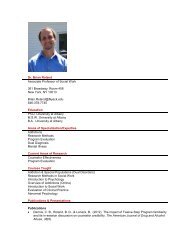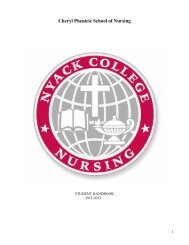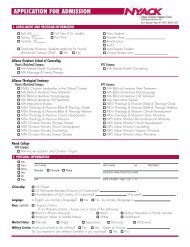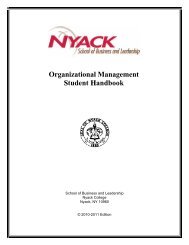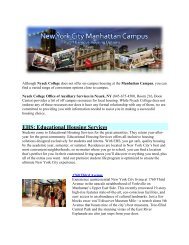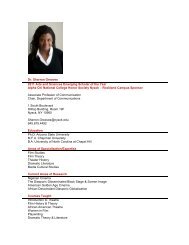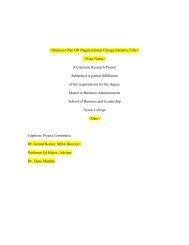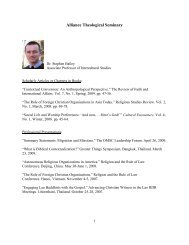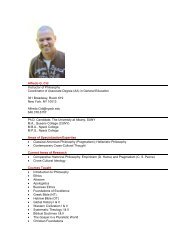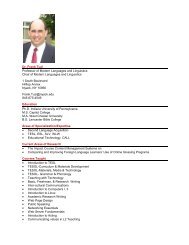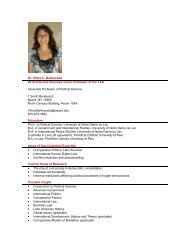Overview of critical thinking support materials.pdf - Nyack College
Overview of critical thinking support materials.pdf - Nyack College
Overview of critical thinking support materials.pdf - Nyack College
Create successful ePaper yourself
Turn your PDF publications into a flip-book with our unique Google optimized e-Paper software.
Insight Assessment<br />
Critical Thinking Resources<br />
Tools to Support Teaching and Learning<br />
Offered with the Adoption <strong>of</strong> Testing Instruments from Insight Assessment:<br />
Focused Training Strategies to Improve Critical Thinking<br />
The Holistic Critical Thinking Scoring Rubric (HCTSR)<br />
Critical Thinking: What It Is and Why It Counts<br />
The Power <strong>of</strong> Asking Good Questions<br />
Critical Thinking Training Session Feedback<br />
Strong Critical Thinking in Groups<br />
Critical Thinking Reflective Log<br />
“Evaluating the Credibility <strong>of</strong> Sources”<br />
The Rubric for Evaluating Written Argumentation (REWA)<br />
1) Focused Training Strategies to Improve Critical Thinking is a <strong>thinking</strong> exercise designed to assist instructors to<br />
strengthen the teaching and learning strategies that they use to improve <strong>critical</strong> <strong>thinking</strong> skills and habits <strong>of</strong><br />
mind. This thoughtful self-evaluation tool is also a powerful self-help guide to assist pr<strong>of</strong>essional development<br />
for those focused on training <strong>critical</strong> <strong>thinking</strong>. The instructor who repeats this <strong>thinking</strong> exercise periodically will<br />
gain insights into their own best teaching practices and continuously improve their effectiveness in training<br />
strength in <strong>critical</strong> <strong>thinking</strong>.<br />
2) Critical Thinking: What it is and Why It Counts an essay written by Dr. Peter Facione, a leading authority in<br />
<strong>critical</strong> <strong>thinking</strong>. This essay is periodically updated to capture new findings and discussion points to help<br />
learners explore the domain <strong>of</strong> <strong>critical</strong> <strong>thinking</strong> in all aspects <strong>of</strong> life and work, The original appeared in 1992.<br />
Author and the publisher hold copyright, ISBN 13: 978-1-891557-07-1. Permission is granted for paper,<br />
electronic, or digital copies to be made in unlimited amounts for purposes <strong>of</strong> advancing education and<br />
improving <strong>critical</strong> <strong>thinking</strong>, provided that distribution <strong>of</strong> copies is free <strong>of</strong> charge and provided that material is<br />
properly cited when extracted in whole or in part. For permission to reprint or permissions for intended resale,<br />
contact James Morante at 650-697-5628 or jmorante@insightassessment.com.<br />
3) Strong Critical Thinking in Groups is designed to <strong>support</strong> and augment the benefits <strong>of</strong> strong <strong>critical</strong> <strong>thinking</strong><br />
educational <strong>of</strong>ferings which contain group projects, discussions or presentations. This one page tool guides<br />
learners through an evaluative <strong>thinking</strong> exercise where they must rate the quality <strong>of</strong> the <strong>critical</strong> <strong>thinking</strong><br />
demonstrated by the group effort. When used by a person who is observing a group process, this tool<br />
maximizes active learning by requiring the rater to explain the basis for his or her ratings <strong>of</strong> the group’s work at<br />
framing their problem, their analysis <strong>of</strong> the problem, and their formulation <strong>of</strong> solutions. When used after a<br />
group <strong>thinking</strong> exercise by participants in the group, the tool assists in reflection about the quality <strong>of</strong> the<br />
learning experience just completed.<br />
4) The Holistic Critical Thinking Scoring Rubric (HCTSR) is a rating measure that can be used to assess the quality <strong>of</strong><br />
<strong>critical</strong> <strong>thinking</strong> displayed in a verbal presentation or written text. One would use the HCTSR to rate a written<br />
document or presentation where the presenter is required to be explicit about their <strong>thinking</strong> process. It can be used in<br />
any educational program or assessment process. Its greatest value is obtained when used by learners to assess the<br />
quality <strong>of</strong> their own or another’s reasoning. The clearly described criteria assist the learner to internalize the<br />
characteristics <strong>of</strong> strong and weak <strong>critical</strong> <strong>thinking</strong>. If you plan to use this instrument to assess <strong>critical</strong> <strong>thinking</strong> for any<br />
high stakes purposes, you must remember that your ratings will only be as valid as the strength <strong>of</strong> your raters. You will<br />
Critical Thinking Teaching and Support Resources distributed by Insight Assessment<br />
Measuring Critical Thinking Worldwide<br />
www.insightassessment.com<br />
Use permissions – Contact Insight Assessment 650-697-5628
Insight Assessment<br />
Critical Thinking Resources<br />
need to train the raters well to assure that they are making accurate ratings (judgments) about the evidence <strong>of</strong> <strong>critical</strong><br />
<strong>thinking</strong> that they are observing and evaluating. It would be important to select a task, presentation, or written<br />
product where the thinker has been asked to explain their <strong>thinking</strong> and not just to provide the conclusions they have<br />
reached in regard to a particular dilemma. The validity and reliability <strong>of</strong> all such rubrics (rating forms) is judged by the<br />
Kappa Statistic. Rating tools are generally considered weaker measures <strong>of</strong> <strong>critical</strong> <strong>thinking</strong> than the other validated<br />
standardized instruments.<br />
5) The Power <strong>of</strong> Asking Good Questions is a teaching tool designed to assist instructors in engaging students’<br />
<strong>critical</strong> <strong>thinking</strong>. By asking questions like those listed in this table, instructors can raise the quality <strong>of</strong> classroom<br />
discussions from simple information sharing and opinion giving to the level <strong>of</strong> analysis, interpretation,<br />
inference, explanation, evaluation and self-reflection. This tool appears on page 8 <strong>of</strong> “Critical Thinking: What It<br />
is and Why It Counts” and in THINK Critically, Facione and Gittens, Pearson Education.<br />
6) Critical Thinking Training Session Feedback is a tool intended to function as both a self evaluation tool for the<br />
learner and as an evaluation <strong>of</strong> the educational <strong>of</strong>fering itself for its ability to engage the learner as intended.<br />
The exercise <strong>of</strong> completing the form asks the learner to reflect specifically on their <strong>thinking</strong> experience related<br />
to the learning opportunity. Responses for each <strong>of</strong> the individual items are informative, and as a collection they<br />
serve as a subjective report <strong>of</strong> the learner’s experience. This is not a direct measure <strong>of</strong> the objective quality <strong>of</strong><br />
the learning outcome, and is NOT intended as a measure <strong>of</strong> strength or weakness in the learner’s actual<br />
<strong>critical</strong> <strong>thinking</strong> ability. Self-assessments (self-report measures) <strong>of</strong> <strong>thinking</strong> ability have been shown to be<br />
falsely positive.<br />
7) Critical Thinking Reflective Log – This <strong>critical</strong> <strong>thinking</strong> tool is intended to give structure and focus to journaling<br />
assignments made by many teachers and pr<strong>of</strong>essors to assist students to integrate their learning experiences.<br />
As written it is aimed at the undergraduate level learner or novice pr<strong>of</strong>essional, but it is easily adapted for use<br />
in other populations. Use the Reflective Log to coach and guide meta-cognition, to develop students' selfmonitoring<br />
and self-correction skills.<br />
8) “Evaluating the Credibility <strong>of</strong> Sources” explains the considerations which are relevant to the evaluation <strong>of</strong><br />
expertise. It is a teaching tool which enables instructors to guide students’ <strong>critical</strong> <strong>thinking</strong> about what to<br />
believe or not to believe when they encounter claims on the Internet, TV, <strong>of</strong> social media, or in the forms <strong>of</strong><br />
advertising, rumors, hearsay, assertions by persons in power, celebrities, friends, etc. These pages are<br />
extracted from THINK Critically, Facione & Gittens, Pearson Education and <strong>of</strong>fered here with the author’s<br />
permission not only as a teaching tool, but as an example <strong>of</strong> the quality and practical utility <strong>of</strong> that book.<br />
9) The Rubric for Evaluating Written Argumentation (REWA) is designed to provide detailed feedback on how<br />
written material that is intended to argue persuasively on behalf <strong>of</strong> a given claim, opinion, or recommendation<br />
might be improved. This rubric addresses eight different aspects <strong>of</strong> sound and effective writing: Purpose and<br />
Focus, Depth <strong>of</strong> Thought, Thesis, Reasoning, Organization, Voice, Grammar and Vocabulary, and Mechanics <strong>of</strong><br />
Presentation.<br />
Critical Thinking Teaching and Support Resources distributed by Insight Assessment<br />
Measuring Critical Thinking Worldwide<br />
www.insightassessment.com<br />
Use permissions – Contact Insight Assessment 650-697-5628



